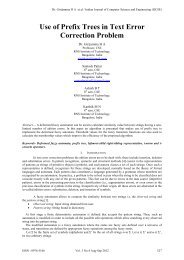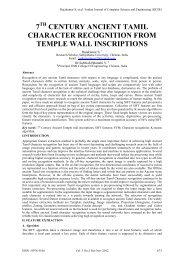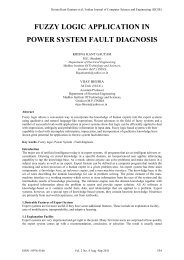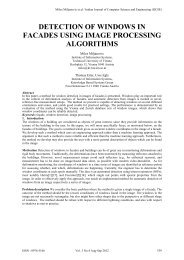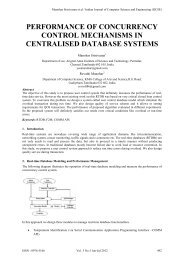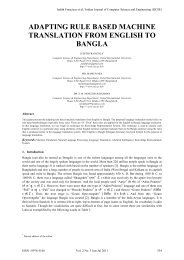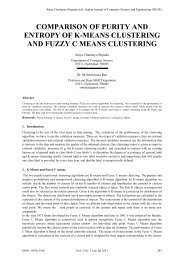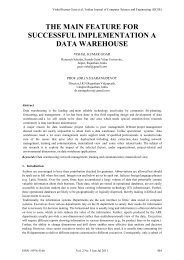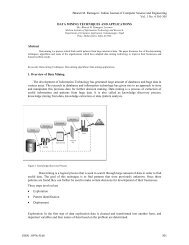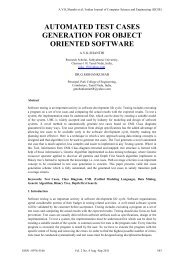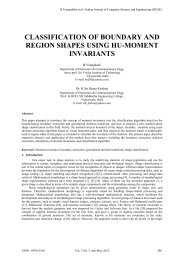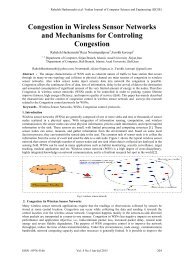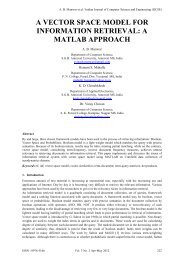petri nets generating kolam patterns - Indian Journal of Computer ...
petri nets generating kolam patterns - Indian Journal of Computer ...
petri nets generating kolam patterns - Indian Journal of Computer ...
You also want an ePaper? Increase the reach of your titles
YUMPU automatically turns print PDFs into web optimized ePapers that Google loves.
D. Lalitha et al / <strong>Indian</strong> <strong>Journal</strong> <strong>of</strong> <strong>Computer</strong> Science and Engineering (IJCSE)XIf σ(T)={X →X, tmX→B, bmX→B }. The resultant array reaching the output place would be XXDXXBX .X X X BRow Rule:In case all X in the first row (last row) <strong>of</strong> the array is not required to be joined to X using up rule (down rule). Ifthe leftmost(lm) X and rightmost(rm) X is to be joined to a blank tile then we use the notation lmX↑B (lmX↓ B),rmX↑B (rmX↓ B). Except the first X and the last X <strong>of</strong> the row all the other X are catenated to X in a parallelXmanner. For example let the input place <strong>of</strong> a transition T have the array XXDXX .X X XBIf σ(T)={ lmX↑B, rmX↑B, X ↑X, }. The resultant array reaching the output place would beXXXFor example consider the net in the following figureXXDXBX.XXP 1t 1P 2At 2P 3If A =XXXXDXYreaches the place p 2 is YYXX , σ(t 1 ) = {X ←Y} and σ(t 2 ) = { lmX↑B, rmX↑B, X ↑X, } then after firing t 1 the array thatXXXXXDXXX . All X in the first column is joined to y in the left. Once this array reachesXB B X Bp 2 the transition t 2 is enabled and so when t 2 fires the array that reaches p 3 will beY X X X. The left mostY X D XY X X X<strong>of</strong> X and the right most <strong>of</strong> X are joined to a blank tile and the middle X is joined to X. Since no rule is given forY it is being joined with a blank tile. All these catenations are done in the upward direction. In general all rulesare applied in a parallel manner unless the prefix rm, lm, tm and bm is used along with a rule. Hence we call itsequential/parallel generation.Definition 4. A Kolam Array Token Petri Net Structure (KATPNS) is a four tuple (C, Σ, σ, F) whereC = (P, T, I, O) is a Petri net structure, Σ an alphabet <strong>of</strong> square tiles <strong>of</strong> same size, σ partial function on the set <strong>of</strong>transitions which define the labels, M 0 :P→Σ ** is the initial marking and F ⊆ P is a set <strong>of</strong> final places.Definition 5. The language generated by the KATPNS is L(C) = {A Σ ** / A is in p for some p in F}. Witharrays <strong>of</strong> Σ ** in some places as initial marking all possible sequences <strong>of</strong> transitions are fired. The set <strong>of</strong> all arrayscollected in the final places F is called the language generated by C.Example 1. The KATPNS (C, Σ, σ, F) where the graph <strong>of</strong> C is given in fig 6, Σ ={X, T, R, D, L, C 1 , C 2 ,C 3 , C 4 },σ the partial function is given in fig 5, S = X is the initial marking in p 1 and p 3 and F = {p 2 }. The generation hereis parallel. The tiles are given in fig 4. The arrays reaching p 2 are collected as the language generated.C 1C 2C 3C 4TRLDXfig 4ISSN : 0976-5166 Vol. 3 No. 1 Feb-Mar 2012 71



